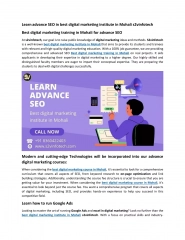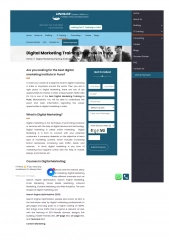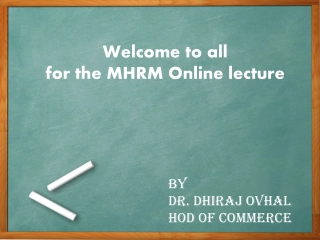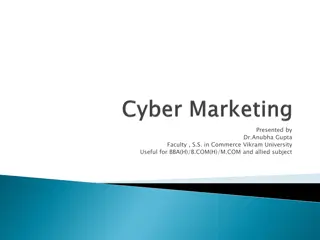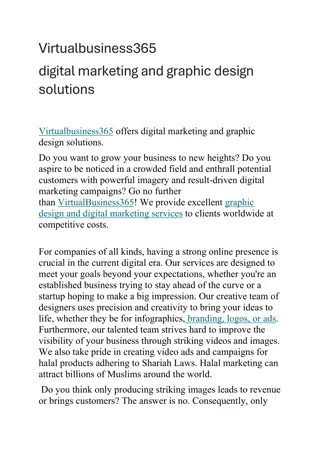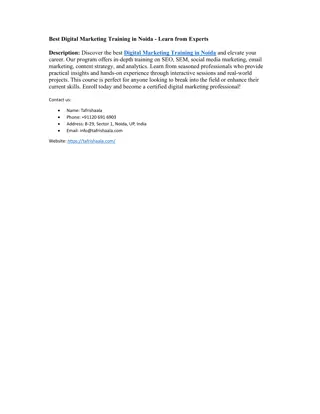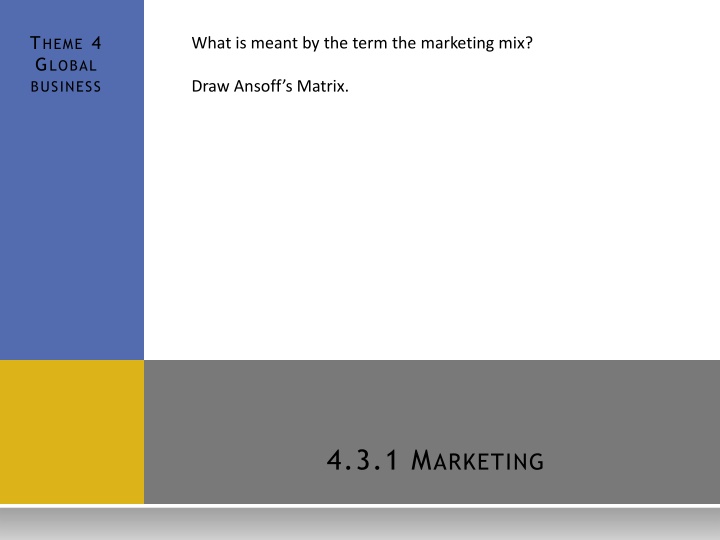
Global Marketing Strategy and Glocalisation
Explore the concept of the marketing mix and Ansoff's Matrix in the context of global business. Learn about global marketing strategy, glocalisation, and different marketing approaches such as domestic/ethnocentric models. Understand the importance of adapting the marketing mix to target global markets effectively.
Download Presentation

Please find below an Image/Link to download the presentation.
The content on the website is provided AS IS for your information and personal use only. It may not be sold, licensed, or shared on other websites without obtaining consent from the author. If you encounter any issues during the download, it is possible that the publisher has removed the file from their server.
You are allowed to download the files provided on this website for personal or commercial use, subject to the condition that they are used lawfully. All files are the property of their respective owners.
The content on the website is provided AS IS for your information and personal use only. It may not be sold, licensed, or shared on other websites without obtaining consent from the author.
E N D
Presentation Transcript
THEME 4 GLOBAL BUSINESS What is meant by the term the marketing mix? Draw Ansoff s Matrix. 4.3.1 MARKETING
4.3.1 MARKETING In this topic you will learn about Global marketing strategy and global localisation (glocalisation) Different marketing approaches: domestic/ethnocentric mixed/geocentric international/polycentric Application and adaptation of the marketing mix (4Ps) and Ansoff s Matrix to global markets
GLOBALMARKETINGSTRATEGY A global marketing strategy is the adaptation of a marketing strategy to target all markets on a worldwide scale. This has evolved from national and international marketing where businesses market their products in the domestic market or in another country or group of countries. The traditional marketing mix or 4Ps is used with the aim of sending an identical message to all countries. This will have to be adapted e.g. in terms of language or religion but changes are kept to a minimum in each market.
GLOCALISATION Glocalisation is the adaptation of a global marketing strategy in order to meet the requirements of local geographic markets. The term is a mix of globalisation and localisation. A business is more likely to be successful if its global product can meet local requirements and fit in with the customs and religions of the geographic area. Examples of glocalisation. Although global companies would like to sell a standard product in a global market it requires significant investment in market research in order to understand local requirements. Often, it is the local people and practices that create the glocalisation rather than the business. In China, McDonald s is seen as a place for young couples to have their first date! How McDonalds conquered India.
DIFFERENTMARKETINGAPPROACHES: DOMESTIC/ETHNOCENTRIC The EPG model is a framework that can used to look at marketing approaches used by global firms. Ethnocentricity as a marketing approach is where the promotion of the product is undertaken based on the beliefs of the home nation of the business and is presented to the host nation as such. In a sense it is suggesting that the values of the host nation are superior to other nations. Therefore, products are marketed in foreign countries based on the perceived superiority of the host nation s values. To some extent, this approach ignores local customs, culture and religion. The home nation is where the business originated e.g. the USA. Decision making is centralised and key personnel from headquarters are sent to oversee marketing operations in other countries. This restricts promotion prospects for key marketing people who are not from the home nation and marketing ideas from the local area. The host nation is where the target market or subsidiary of the business is based e.g. India. This could be contentious if it offends the local population. However, often, the marketing is of an inoffensive nature in the first place.
DIFFERENTMARKETINGAPPROACHES: INTERNATIONAL/POLYCENTRIC Polycentricity as a marketing approach is where the promotion of the product is undertaken based on the beliefs of the nation in which the business is operating. In a sense it is the direct opposite of ethnocentrism, suggesting that the values of the nation being targeted are all important. Therefore, products are marketed in foreign countries based on the foreign nation s values, fully taking into account local customs, culture and religion. Decision making is decentralised and key personnel need to be recruited from the nation being targeted. This can create significant problems as recruitment might be difficult and there is a loss of control of marketing operations. Local knowledge can be used in the marketing. However, there might be a loss of sales as the product is no longer differentiated from other local competition.
DIFFERENTMARKETINGAPPROACHES: MIXED/GEOCENTRIC Geocentricity as a marketing approach is where the promotion of the product is undertaken based on a global or worldly point of view. Therefore, it is not based on the perspective of either the home or host nation. Marketing is undertaking for the benefit of the business on a global basis. It does not matter where the headquarters or the subsidiary is located; they are a seamless entity, working as one rather than individually. What matters is that each element of the business helps in meeting its global objectives. Employees are selected based on ability rather than nationality. Therefore, products are marketed in foreign countries based on whatever is required for the business to succeed. This might entail marketing based on the home nation s values or based on the host nation s. This will depend upon the nation being targeted. This marketing approach mixes elements of ethnocentric with elements of polycentric.
APPLICATIONANDADAPTATIONOF THEMARKETINGMIX (4PS) TOGLOBALMARKETS The marketing mix needs to be applied effectively to global markets in order to be of use to the business. Ideally, a business would want to market the same product, at the same price, using the same promotional techniques and distribute and sell through the same outlets. However, this might have to be changed to cater for the different needs of national markets. Often, the product will be the most important factor. A firm will need to consider whether a standardised product can be sold on all global markets. Then it can build up an associated product range. This might be easier for a technological business as opposed to a food business. Even technology will be dependent on the infrastructure available in a country e.g. will the internet in some countries allow the use of the latest iPhone.
EGP MODEL In the specification these 3 different marketing approaches are shown as: domestic/ethnocentric mixed/geocentric international/polycentric How do the blue parts help to understand the terms?
APPLICATIONANDADAPTATIONOF THEMARKETINGMIX (4PS) TOGLOBALMARKETS A global standardised price removes the possibility of the product being sold on in a grey market, where people simply take advantage of the difference in price and sell it on e.g. through Amazon or e-Bay. However, this would not take into account the level of disposable income that people have so might mean that a business is reducing the sales revenue available to it. How has Foodpanda changed the marketing mix? Global promotion e.g. one form of advertising to all countries will allow marketing economies of scale but will not take into account local customs, cultures etc. Finally, place will differ dependent on the type of product. For example, can it be sold through the internet or does it require specialist customer service and associated outlets.
APPLICATIONANDADAPTATIONOF ANSOFF S MATRIXTOGLOBALMARKETS Ansoff s Matrix is a useful strategic tool when looking at how a business should approach global markets. A business might wish to pursue a strategy of market penetration targeting the same customer base in its current global markets. To do this it will look at its EPG marketing approach and decide where and how to invest. This will be dependent on the forecast return on investment from each market that it already operates in. It will look to see if it should continue its current approach e.g. ethnocentric or adapt it to meet the changing requirements of the market e.g. to one of geocentricity. Global businesses will always be looking to pursue a strategy of new market development. As markets grow and disposable incomes increase then there is an increased attractiveness for global businesses. Again, using the EPG model, how they approach this is dependent on the type of business and the type of market.
APPLICATIONANDADAPTATIONOF ANSOFF S MATRIXTOGLOBALMARKETS New product development will take into account the needs of global and international markets. Global businesses spend billions on research and development in order to innovate and constantly bring out new products, particularly when old products are in decline. However, whether this is a standardised product or caters for specific national needs is dependent on the type of product. For example, Asian skincare often requires different products then European skincare. Therefore, businesses such as L Oreal will design specific products for different countries. Diversification for a global business is a risky strategy. Often, this will be undertaken through takeovers and mergers. Here the global business can use its core functional skills such as finance, marketing and distribution. However, it gains the skills of the business taken over. For example, a business might take over a highly skilled workforce and allow it to continue product innovation. However, the business will use its global marketing and distribution expertise to gain greater access to markets.
DISCUSSION What is more important to success adapting to local needs or the cost benefits of a homogenous product? Try to use the terms ethnocentric, geocentric and polycentric in your discussion
4.3.1 MARKETING In this topic you have learnt about Global marketing strategy and global localisation (glocalisation) Different marketing approaches: domestic/ethnocentric mixed/geocentric international/polycentric Application and adaptation of the marketing mix (4Ps) and Ansoff s Matrix to global markets




